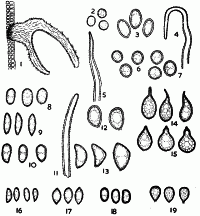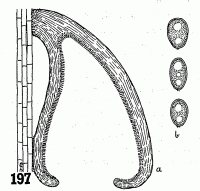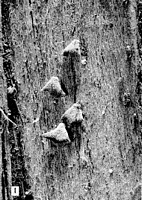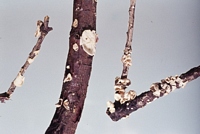|
 Calyptella totara Calyptella totara
SynonymsLachnella totara
Cyphella totara
Cyphella cupuliformis
BiostatusPresent in region - Indigenous. Endemic
Images (click to enlarge)
Caption: FIG. 10: Spores of Cyphella totara. | 
Caption: FIG. 197. Lachnella totara. Section through a small pileus pendent from the vertex (a)
and ovate or elliptical spores (b). | 
Caption: PLATE V. FIG. 1. Lachnella totara, × 4
Pendent pilei growing on the surface of bark of erect living trunk of Podocarpus
totara. | 
Owner: Herb. PDD | |
Article: Cunningham, G.H. (1963). The Thelephoraceae of Australia and New Zealand. New Zealand Department of Scientific and Industrial Research, Bulletin 145: 359 p. Wellington:.
Description: Pilei annual, scattered, membranous-coriaceous, 2-3 mm long, 1-8 mm broad, usually
pendulous when attached by narrow vertices, conical-cupulate when seated upon
narrow bases, or sometimes scutellate and attached by broad bases; exterior fawn or
tan, darker peripherally, finely radiate striate, or wrinkled, naked; margin acute,
inturned or plane, entire or slightly lacerate; hymenial surface even or slightly
rugulose, bay, concave. Context white (brown in some old specimens), to 250 µ,
thick, of radiately arranged, compact, parallel hyphae; generative hyphae 4-5 µ,
diameter, walls 1 µ, thick, hyaline, tortuous. Hymenial layer to 70 µ deep, a dense
palisade of basidia and paraphyses. Basidia clavate, 40-56 x 7-9 µ, bearing 2-4 spores;
sterigmata erect, slender, to 5 µ long. Paraphyses subclavate, 32-48 x 6-7 µ. Spores
obovate or elliptical, apiculate, 8-9.5 x 5-6 µ, walls smooth, hyaline, 0.2 µ thick.
Habitat: HABITAT: Scattered on bark of living and dead branches and trunks.
Distribution: TYPE LOCALITY: Peel Forest, Canterbury, New Zealand.
DISTRIBUTION: New Zealand.
Notes: Common on two endemic species of Podocarpus, called totara by the Maori, the
species possesses the largest pilei of any present in the region. Usually 1-3 mm
diameter, pendulous and conical-cupulate (as in the type collection), pilei sometimes
may extend laterally to 8 mm, and become scutellate with a slightly wrinkled
hymenial surface. Pilei grow upon bark of living or dead branches and small trunks,
and because of the exterior colour are difficult to detect. In Kew herbarium there is a
collection, ex "Buller Valley, Westland, T. Kirk, No. 236" which Cooke placed under
the cover of `Cyphella' cupulaeformis Berk. & Rav. The latter differs in possessing
markedly angular, distorted, irregular spores
Article: Cunningham, G.H. (1948). New Zealand Polyporaceae. 3. The genus Polyporus. New Zealand Department of Scientific and Industrial Research, Plant Diseases Division, Bulletin 74: 39 p.
Description: Pilei annual, scattered, membranous, tough, 2-3 mm. long, 1-3 mm. broad, pendulous when
attached by a narrow vertex, or conical-cupulate when seated upon a somewhat broad base;
exterior surface fawn or tan, darker peripherally, finely radiate-striate, or wrinkled, naked;
margin acute, inturned or plane, entire or slightly lacerate; hymenial surface even, concave,
bay-brown. Context white (brown in some old specimens), 150-250 µ thick, to 500 µ at the
base, of radiately arranged sclerotioid compact hyphae; generative hyphae to 5 µ diameter,
wall 1 µ thick, hyaline, branched, septate, tortuous. Hymenial layer to 70 µ deep, paraphyses
subclavate. Basidia clavate, 40-56 x 7-9 µ, 2-4-spored. Spores obovate or elliptical, apiculate,
8-9.5 x 5-6 µ, smooth, hyaline.
Habitat: HABITAT. Scattered on bark of living and dead branches.
Distribution: DISTRIBUTION. New Zealand.
Notes: The species is common on two endemic species of Podocarpus, called totara by the Maori,
hence its specific name. It is often present on bark of living trunks or branches, though as
frequent on dead branches. Close to C. hebe, it may be separated by the usually much larger
size of pilei, thicker context with different hyphae, and differently shaped shorter spores. In
Kew herbarium is filed one collection, ex totara bark, Buller Valley, Westland, T. Kirk, No.
236. It was placed by Cooke under the cover of C. cupulaeformis Berk. & Rav., a species
which differs in possessing markedly angular, distorted, and irregular spores.
|